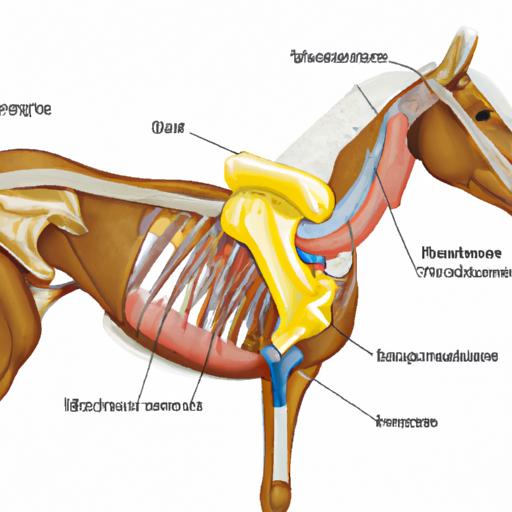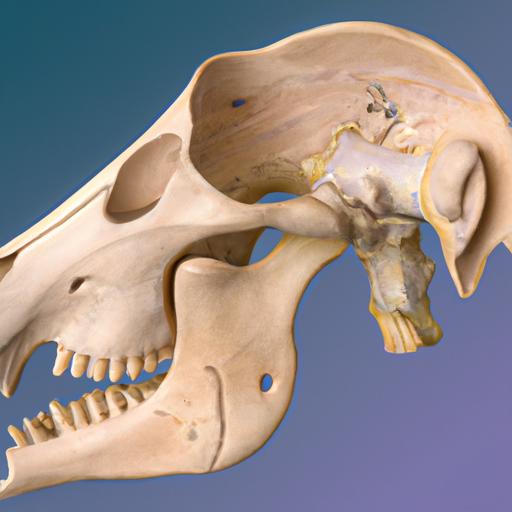Unlock the secrets of the mastoid process of temporal bone in horses. Discover its role in equine health, performance, and veterinary examinations.
Introduction

The majestic beauty of horses has captivated us for centuries, but have you ever wondered about the intricate details of their anatomy? Today, we delve into the fascinating world of equine anatomy, focusing on a vital structure known as the mastoid process of the temporal bone. In this article, we will explore its significance, functions, and common conditions associated with it. So, saddle up and let’s embark on this enlightening journey together.
Overview of the Mastoid Process of Temporal Bone in Horses
The mastoid process is a prominent feature located on the temporal bone of horses. It protrudes behind the ear, resembling a sturdy fortress guarding the delicate structures within. This bony projection serves as an attachment site for various muscles, tendons, and ligaments, playing a crucial role in the horse’s overall movement and stability.
Importance of Understanding the Mastoid Process in Equine Anatomy
As responsible horse owners, trainers, or veterinarians, a deep understanding of equine anatomy is paramount. The mastoid process holds significant importance due to its involvement in maintaining equilibrium and balance, especially during strenuous activities such as jumping or galloping. By comprehending the intricacies of this structure, we can better appreciate the horse’s physical capabilities and address potential issues promptly.
Purpose of the Article
The purpose of this article is to provide a comprehensive and accessible resource on the mastoid process of the temporal bone in horses. We aim to equip you with the knowledge necessary to identify potential disorders and understand their impact on equine health and performance. So, whether you are a passionate equestrian or a curious enthusiast, join me as we unravel the secrets of the mastoid process and unlock a deeper understanding of our equine companions.
Stay tuned for the upcoming sections, where we will explore the anatomy, development, and common conditions associated with the mastoid process in horses. Together, let’s gain insights that will enrich our appreciation for these magnificent creatures.
Anatomy of the Mastoid Process in Horses
A. Definition and Location of the Mastoid Process
When it comes to understanding the mastoid process in horses, it’s essential to start with its definition and location. The mastoid process is a bony prominence situated at the base of the skull, just behind the ear. This robust structure serves as an attachment point for muscles and ligaments involved in head and neck movements, making it a key component of equine anatomy.
B. Structure and Composition of the Temporal Bone
To truly grasp the significance of the mastoid process, we must delve into the structure and composition of the temporal bone. The temporal bone is a complex structure that houses vital sensory organs, such as the inner ear. Within this bone, the mastoid process is prominent, featuring a dense and compact structure that provides strength and stability.
The temporal bone consists of various components, including the squamous, petrous, and tympanic parts. Each part contributes to the overall structure and function of the mastoid process. The squamous part forms the flat, upper region of the temporal bone, while the petrous part houses the inner ear structures responsible for hearing and balance. The tympanic part, also known as the ear canal, connects the middle ear to the external environment.
C. Function and Role of the Mastoid Process in Equine Anatomy
Now, let’s uncover the function and role of the mastoid process in equine anatomy. The mastoid process serves as a crucial attachment site for muscles involved in head movement, such as the sternomastoid and splenius muscles. These muscles work in harmony to facilitate various actions, including flexion, extension, and rotation of the head.
Additionally, the mastoid process plays a vital role in maintaining equilibrium and balance. It acts as a counterbalance, helping the horse stabilize its head and neck during dynamic movements. This stability is particularly crucial during activities that require precise coordination, such as jumping or navigating uneven terrain.
By understanding the anatomy of the mastoid process, we gain valuable insights into the horse’s physical capabilities and the importance of this structure in their overall well-being. In the following sections, we will explore the development and growth of the mastoid process, as well as common conditions and disorders associated with it. Stay tuned to expand your knowledge further!
Development and Growth of the Mastoid Process in Horses
Embryonic Development of the Mastoid Process
The journey of the mastoid process begins in the early stages of embryonic development. As the horse’s skeletal system takes shape, the temporal bone gradually forms, eventually giving rise to the mastoid process. This intricate process involves the intricate interplay of genetic factors, signaling molecules, and cellular interactions that orchestrate the growth and differentiation of bone tissue.
Factors Influencing the Growth and Formation of the Mastoid Process
Several factors influence the growth and formation of the mastoid process in horses. Proper nutrition plays a vital role, as a well-balanced diet ensures the availability of essential minerals and vitamins necessary for optimal bone development. Additionally, genetics and breed characteristics may contribute to variations in the size and shape of the mastoid process among different horse breeds.
Environmental factors, such as exercise and physical activity, also impact the growth of the mastoid process. Regular exercise promotes bone remodeling and strengthens the attachment of muscles and ligaments to the mastoid process, enhancing the horse’s overall stability and performance.
Changes in the Mastoid Process during the Horse’s Lifetime
Just like the horse’s overall skeletal system, the mastoid process undergoes changes throughout its lifetime. During the early years of growth, the mastoid process gradually fuses with the surrounding temporal bone, becoming more pronounced and structurally robust. As the horse ages, there may be subtle changes in the shape and size of the mastoid process due to natural bone remodeling processes and the effects of wear and tear.
Understanding the developmental stages and changes in the mastoid process is crucial for assessing the horse’s overall health and identifying potential abnormalities or deviations from the norm. By keeping a keen eye on these changes, veterinarians and horse owners can ensure early detection and appropriate management of any issues that may arise.
In the following sections, we will explore common conditions and disorders associated with the mastoid process in horses, shedding light on their causes, symptoms, and treatment options. Stay with us as we unravel the mysteries surrounding the mastoid process, piece by piece.
Common Conditions and Disorders Associated with the Mastoid Process in Horses
The mastoid process of the temporal bone is not invulnerable to various conditions and disorders that can affect the overall well-being of our equine companions. In this section, we will explore some of the common issues that can arise concerning the mastoid process and delve into their causes, symptoms, and potential treatments.
A. Mastoiditis in Horses: Causes, Symptoms, and Treatment
Mastoiditis, an inflammation of the mastoid process, can cause significant discomfort and hinder a horse’s performance. This condition often occurs as a secondary infection following respiratory or middle ear infections. The bacteria or viruses responsible for the initial infection can spread to the mastoid process, leading to inflammation and potential complications.
Symptoms of mastoiditis may include swelling, tenderness, and heat around the affected area. Horses may exhibit signs of pain, such as head shaking, reluctance to be bridled, or ear sensitivity. In severe cases, an abscess or discharge may be present.
Treatment for mastoiditis typically involves a combination of antibiotics, pain management, and supportive care. Veterinary intervention is crucial to accurately diagnose the condition and prescribe the appropriate antibiotics to combat the infection effectively.
B. Otitis Media and its Impact on the Mastoid Process
Otitis media, an inflammation of the middle ear, can have repercussions on the mastoid process in horses. This condition often arises from the spread of infection from the upper respiratory tract or external ear canal. If left untreated, the infection can progress and involve the mastoid process, leading to further complications.
Common symptoms of otitis media include head tilting, ear discharge, and behavior changes. Horses may exhibit signs of discomfort, such as rubbing their ears against objects or shaking their heads vigorously.
Treatment for otitis media involves a thorough examination by a veterinarian to determine the extent of the infection. Antibiotics, anti-inflammatory medications, and ear cleaning may be prescribed to address the underlying infection and alleviate symptoms.
C. Traumatic Injuries and Fractures of the Mastoid Process
Traumatic injuries and fractures to the mastoid process can occur due to accidents, falls, or direct blows to the head. These injuries can cause severe pain, swelling, and even affect the horse’s balance and coordination.
If a traumatic injury or fracture is suspected, immediate veterinary attention is crucial. Diagnostic imaging, such as X-rays or CT scans, may be necessary to assess the extent of the damage. Treatment options can range from conservative management with pain medication and immobilization to surgical intervention, depending on the severity of the injury.
By being aware of these common conditions and disorders associated with the mastoid process, we can promptly recognize and address any issues that may arise. Remember, early detection and appropriate treatment are vital for ensuring the well-being and performance of our equine companions.
Conclusion
In conclusion, the mastoid process of the temporal bone plays a vital role in the overall health and performance of horses. Throughout this article, we have explored its anatomy, development, common disorders, and its impact on equine equilibrium, balance, and performance.
By understanding the significance of the mastoid process, we can recognize the importance of proper care and evaluation in veterinary examinations. Identifying and addressing mastoid process disorders promptly can help prevent potential complications and optimize the horse’s well-being.
At Horsemasterypro.com, we are committed to providing you with comprehensive insights into equine anatomy and health. We hope this guide has shed light on the intricate world of the mastoid process, deepening your understanding of our equine companions.
Remember to consult with a qualified veterinarian for any specific concerns regarding your horse’s mastoid process or overall health. Together, let’s continue to nurture a strong bond with our horses and ensure their well-being for years to come.
Stay connected with Horsemasterypro.com for more informative articles and expert guidance on all things equine.
Bolded: Horsemasterypro.com


